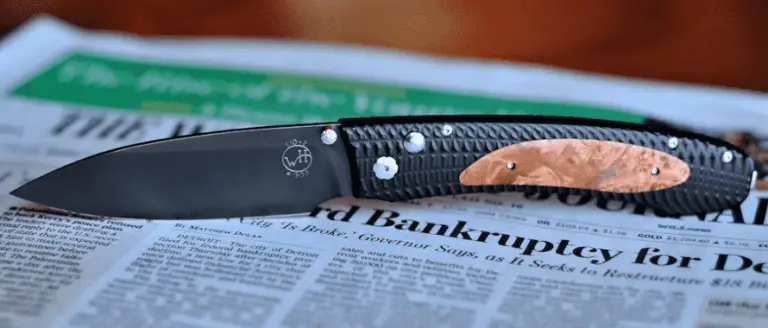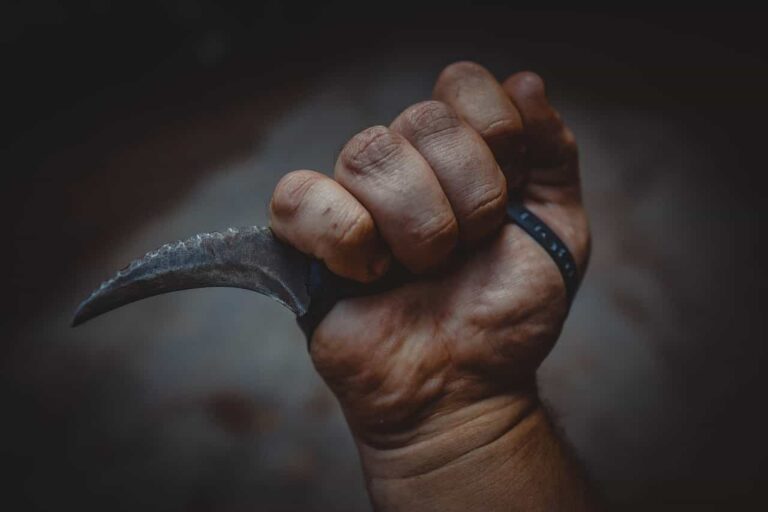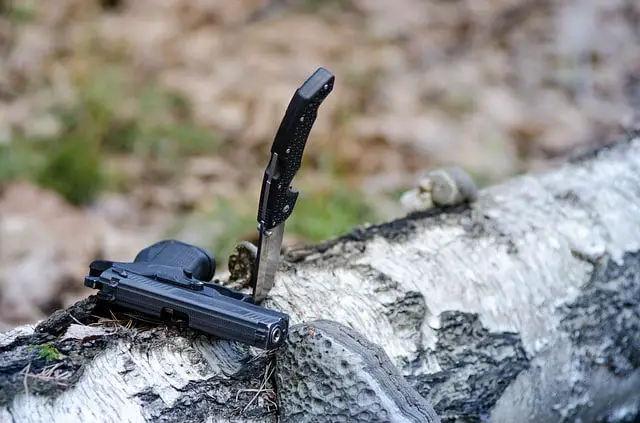The last thing you want to see is a dent in your knife blade. Of course, some microchips happen along the edge of the knife from time to time which is why I recommend you hone your blade after use.
However, when the chip is so serious that you notice it, something is truly wrong already.
In this piece, I answer your question on how knives chip, what to do to prevent it from happening in the first place, and how to manage the situation once it has happened too.
Table of Contents
What can lead to a chipped knife edge?
There are a series of small actions that will lead to a chipped knife bade, either alone or in combination. Here are some worth mentioning:
#1 Moisture on the blade
Tiny chips occur on the blade when the steel becomes weak enough from corrosion as a result of moisture.
Stainless steel can look all that strong but with time, it is subject to getting brittle and less sturdy than when you bought it. Whether you leave water on the blade after washing or forget to rinse off the tomato guts after cutting them, there are a lot of ways your knife can come in touch with moisture.
Prevention: Rinse off the knife blade as soon as you are done using it and clean it off. For high carbon stainless steel knives, you should go the extra mile of oiling the knives before storage, especially if they won’t be used for a long time.
Likewise, take note of the proper storage techniques for your knives so that they are kept free from moisture.
#2 Dropping the knife
Not handling the knife well can cause it to drop onto hard surfaces. Likewise, you can be the most careful person with your knife and it accidentally drops on hard surfaces one day.
These things happen, and it might not be your fault.
On landing, the knife-edge could hit uneven hard surfaces (such as stones) which causes it to chip. The strength of the stainless steel, the height of the drop, and the force with which the knife was dropped all come into play here.
That said, I have mentioned in my kitchen knife safety guide that you never try to catch a falling knife. It is better to pay less than $15 to restore the chip or get another great kitchen knife than suffer a knife injury that could bring other health problems of its own.
Prevention: When doing other stuff, leave your knife on the countertop. When on the countertop or other surfaces, ensure the knife is not at the edge where it can easily drop. Likewise, always place your knife on flat surfaces so that they don’t slide down and drop to the floor on their own.
If using magnetic strips for storage, choose quality strips that are strong enough to hold the knife or simply consider alternative knife storage methods.
#3 Wrong sharpening techniques
In my guide to using a whetstone to sharpen your knives, I hammer consistently on how the sharpening angle is crucial to doing a good job.
One of the many reasons why you need to get the angle right is to prevent chipping.
If you look at the angle on an ax, a razor, and your kitchen knives, you would see that they are not the same. Look at the entire line-up of Coolina knives, for example, and you would see that the set does not come at the same angle either.
The reason for that is that not all of these knives are designed for use the same way. For the knives that require a bit more force in application (such as the meat cleavers), the edges need to be sharpened to a higher degree.
Prevention: Follow the manufacturer’s guide for the best edge angles when sharpening your knives. Don’t assume that because one edge angle works for a knife, it works for another too.
#4 Wrong knife usage
This follows from the above.
If you have been following this blog for a while, you know that I am not a fan of buying an entire knife set for your kitchen if you don’t do a lot of cooking. You can as well just get away with either a chef or santoku knife in combination with a serrated bread knife and paring knife.
However, some cases require that you break out the big guns.
For example, I don’t process a lot of raw meat (since I get them cut to size from the butcher’s shop) so I don’t need a meat cleaver. If I am ever faced with raw meat, though, I don’t think I would like to bring my chef knife down on it.
Deep down, I know that this knife is not made for that and would most likely get damaged on repeated impact. Such use would cause the knife to chip.
Prevention: Choose the right knives for the right job. If in doubt, look through the buying guides that I have specially curated for you to find the best fit for your needs.
#5 Manufacturer’s fault
Sometimes, it’s just not your fault.
You could use the knife the very best way and only take care of it in a way my mother would approve of, yet the blade would chip. In this case, the heat treatment of the blade from the manufacturer could be the issue.
If you have purchased your knife from a reliable brand, the chances of this happening are almost zero. As with any other thing, though, this stuff happens sometimes and there is nothing we can do about it.
Prevention: There isn’t much you can do to prevent this, but you can reduce your chances of getting caught in this situation by buying from a reputable manufacturer in the first place.
How to Fix A Chipped Knife Blade
I have discussed some preventive measures up there. When the deed is done, though, you need to know that you can salvage the knife in some cases.
Yes, I said some cases because you won’t always be able to restore a chipped knife depending on the severity of the chipping.
In the cases where you can, here are some approaches that work best.
Sharpen or hone the chippings out
Remember my guide to sharpening and honing your kitchen knife?
The aim of honing the knife is to set the edge back straight after you have used it for a while and it must have started to get bent out of shape or chip. With your honing rod, you can smoothen the knife-edge again so that the micro serrations and chips are evened out.
For slightly bigger chips, you can choose to sharpen the knife properly. Those who have a Shun knife set can mail the knife back to the company to have it sharpened professionally if you don’t want to do it on your own. You can check with your manufacturer too to see if they offer such services.
Otherwise, ask your friends or a chef you know to recommend where they would go for professional sharpening services.
PS If you want to do this yourself, I found you a nice video guide to that:
Replace knife-edge
When your knife chips seriously at the edge, there is not much that can be done.
I could say that you should ship the knife back to the manufacture so that they fill it with more steel and send it back to you looking new. The truth is, besides the fact that this move would be expensive, you won’t also get uniform steel all around the knife anymore.
Fortunately, some good knife shops can reduce the length of the knife such that they create a new edge and point from the chipped area. Thus, you have the same knife material, only shorter, and for cheaper.
Again, ask for recommendations before you go looking for these shops. Chances are you have a friend (or friend of a friend) that has done something of the sort and can point you in the right direction.
Frequently Asked Questions on Dents in Knife Blade
Is it safe to use a chipped knife?
I am going to assume that you know that the answer to this is negative and you are just tricking me with it.
If you had no idea, though, please note that using any tool that is not in its intended form is dangerous.
A chipped knife is a little more like a dull knife that will require more force to use and might slip to cut you. You also have to consider the fact that some of the chipped steel may remain in the food that you have cut, and I don’t want to imagine what happens if that ends up in someone’s mouth.
Please, either retire your chipped knives or take them in for repairs if you want to keep using them.
Are Japanese knives fragile?
People ask this question because their Japanese knives might be prone to nicks more than the German blades or other brands.
Let’s start with the facts:
Japanese knives are mostly made to be thinner than their western counterpart, but that is not a bad thing. Look at the Kai wasabi knives or check out the amazing Shun knives for example, and you will see what I’m saying.
The issue here, however, is that most of us grew up on those western and German knives so much that we want to use Japanese knives the same way. Instead, you should know which knife is best for what and apply them accordingly.
Here’s a video guide to Japanese knives, and using them the right way:
Can you fix all chipped knives?
Some chips will send the knife to the graveyard while others are small enough that they can easily be restored.
If you know that you can restore a knife from a chip, chances are that you really can – and I recommend that you go for it. When you think otherwise, seek a professional opinion before you decide to recycle/ dispose of the knife.
Seeing as most knife restorations won’t cost you more than $5-$10, I think it’s a fair bet to try rather than spend some money on entirely new knives.
Unless you’ve been looking for an opportunity to buy another knife set anyway, then I’d say you should go for it.







